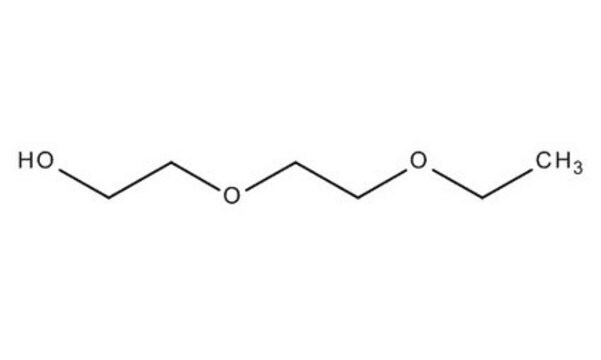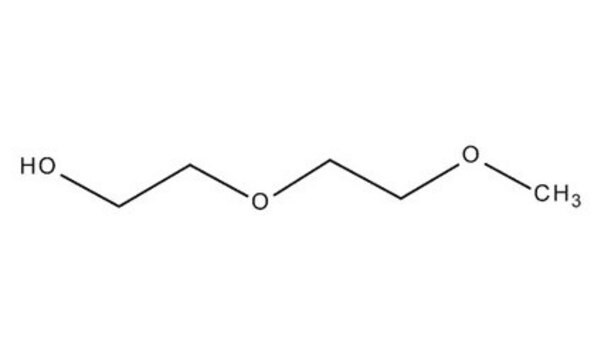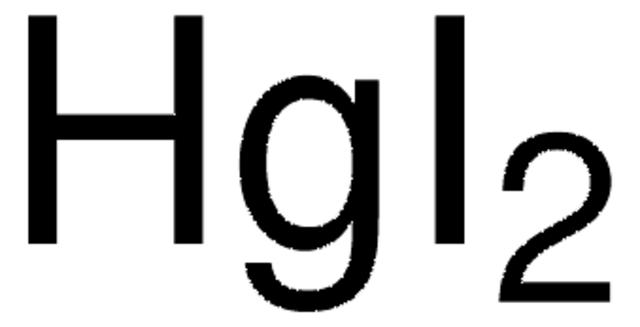8.03129
Diethylene glycol monobutyl ether
for synthesis
Synonyme(s) :
Diethylene glycol monobutyl ether, Butyl carbitol, 2-(2-Butoxyethoxy)ethanol, Butyl diglycol
About This Item
Produits recommandés
Pression de vapeur
<1 hPa ( 20 °C)
Niveau de qualité
Essai
≥98% (GC)
Forme
liquid
Température d'inflammation spontanée
210 °C
Puissance
5660 mg/kg LD50, oral (Rat)
4120 mg/kg LD50, skin (Rabbit)
Limite d'explosivité
0.7-5.9 % (v/v)
pH
7 (20 °C)
Viscosité cinématique
6.1 cSt(20 °C)
pb
226-234 °C/1013 hPa
Pf
-68 °C
Température de transition
flash point 105 °C
Densité
0.95 g/cm3 at 20 °C
Température de stockage
2-30°C
Chaîne SMILES
O(CCOCCCC)CCO
InChI
1S/C8H18O3/c1-2-3-5-10-7-8-11-6-4-9/h9H,2-8H2,1H3
Clé InChI
OAYXUHPQHDHDDZ-UHFFFAOYSA-N
Catégories apparentées
Application
- Biopolymeric Anticorrosion Coatings from Cellulose Nanofibrils and Colloidal Lignin Particles.: This study describes the development of a novel anticorrosion coating made from biopolymers, including a discussion on the use of diethylene glycol monobutyl ether as a solvent to disperse components uniformly (Dastpak et al., 2021).
- The investigation of structural and thermosensitive properties of new phosphazene derivatives bearing glycol and amino acid.: This research article explores the properties of phosphazene derivatives that incorporate glycol structures, detailing methods like NMR and IR spectroscopy where diethylene glycol monobutyl ether may be employed as a solvent in the synthesis process (Uslu and Güvenaltın, 2010).
- Diethylene glycol mono butyl ether concentrations in room air from application of cleaner formulations to hard surfaces.: This study measures the air concentrations of diethylene glycol monobutyl ether in indoor environments following its application in cleaning agents, demonstrating its volatility and potential inhalation exposure during use (Gibson et al., 1991).
Remarque sur l'analyse
Density (d 20 °C/ 4 °C): 0.951 - 0.954
Water (K. F.): ≤ 0.20 %
Peroxide (as H₂O₂): ≤ 0.05 %
Identity (IR): passes test
Mention d'avertissement
Warning
Mentions de danger
Conseils de prudence
Classification des risques
Eye Irrit. 2
Code de la classe de stockage
10 - Combustible liquids
Classe de danger pour l'eau (WGK)
WGK 1
Point d'éclair (°F)
210.2 °F - closed cup
Point d'éclair (°C)
99 °C - closed cup
Certificats d'analyse (COA)
Recherchez un Certificats d'analyse (COA) en saisissant le numéro de lot du produit. Les numéros de lot figurent sur l'étiquette du produit après les mots "Lot" ou "Batch".
Déjà en possession de ce produit ?
Retrouvez la documentation relative aux produits que vous avez récemment achetés dans la Bibliothèque de documents.
Les clients ont également consulté
Notre équipe de scientifiques dispose d'une expérience dans tous les secteurs de la recherche, notamment en sciences de la vie, science des matériaux, synthèse chimique, chromatographie, analyse et dans de nombreux autres domaines..
Contacter notre Service technique













